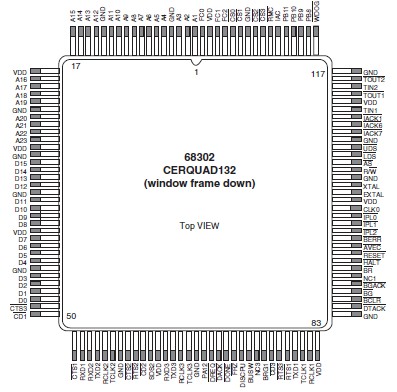Features: • TS68000/TS68008 Microprocessor Core Supporting a 16- or 8-bit TS68000 Family
• System Integration Block Including:
Independent Direct Memory Access (IDMA) Controller
Interrupt Controller with Two Modes of Operation
Parallel Input/output (I/O) Ports, some with Interrupt Capability
On-chip Usable 1152 bytes of Dual-port Random-access Memory (RAM)
Three Timers, including a Watchdog Timer
Four Programmable Chip-select Lines with Wait-state Logic
Programmable Address Mapping of Dual-port RAM and IMP Registers
On-chip Clock Generator with an Output Clock Signal
System Control:
System Control Register
Bus Arbitration Logic with Low Interrupt Latency Support
Hardware Watchdog for Monitoring Bus Activity
Low Power (Standby) Modes
Disable CPU Logic (TS68000)
Freeze Control for Debugging Selected On-chip Peripherals
DRAM Refresh Controller
• Communications Processor Including:
Main Controller (RISC Processor)
Three Full-duplex Serial Communication Controllers (SCCs)
Six Serial Direct Memory Access (SDMA) Channels Dedicated to the Three SCCs
Flexible Physical Interface Accessible by SCCs for Interchip Digital Link (IDL)General Circuit Interface (GCI, see note), Pulse Code Modulation (PCM), and Nonmultiplexed Serial Interface (NMSI) Operation
Serial Communication Port (SCP) for Synchronous Communication, Clock Rate up to 4.096 MHz
Serial Management Controllers (SMCs) for IDL and GCI Channels
• Frequency of Operation: 16.67 MHz
• Power Supply: 5 VDC ± 10%
Pinout Specifications
Specifications
| Symbol |
Parameter |
Min |
Max |
Unit |
| PD |
Power Dissipation (typical at 16.67 MHz)(1) |
53 |
64 |
mA |
| PD |
Power Dissipation (typical at 8 MHz)(1) |
26 |
31 |
mA |
| LPD |
Low Power Mode Dissipation (typical at 16.67 MHz)(2) |
|
36 |
mA |
| LPD |
Lowest Power Mode Dissipation (typical at 16.67 MHz)(3) |
|
32 |
mA |
| LPD |
Lowest Power Mode Dissipation (typical at 50 MHz)(4) |
|
1 |
mA |
Notes: 1. The values shown are typical. The typical value varies as shown, based on how many IMP on-chip peripherals are enabled and the rate at which they are clocked.
2. LPREC = 0. Divider = 2.
3. LPREC = 1. Divider = 1024.
4. The stated frequency must be externally applied to EXTAL only after the IMP has been placed in the lowest power mode with LPREC = 1. The 68000 core is not specified to operate at this frequency, but the rest of the IMP is. In this configuration,the user does not divide the clock internally using the LPCD4-LPCD0 bits in the system control register.
DescriptionThe IMP TS68302 is a very large-scale integration (VLSI) device incorporating the main building blocks needed for the design of a wide variety of controllers. The device is especially suitable to applications in the communications industry. The IMP is the first device to offer the benefits of a closely coupled, industry-standard, TS68000/TS68008 microprocessor core and a flexible communications architecture. This multichannel communications device TS68302 may be configured to support a number of popular industry interfaces, including those for the integrated services digital network (ISDN) basic rate and terminal adapter applications. Through a combination of architectural and programmable features, concurrent operation of different protocols is easily achieved using the IMP. Data concentrators, line cards, bridges, and gateways are examples of suitable applications for this versatile device.
The IMP is a high-density complementary metal-oxide semiconductor (HCMOS) device consisting of a S68000/TS68008 microprocessor core, a system integration block (SIB), and a communications processor (CP). The TS68302 block diagram is shown in Figure 1.Note: GCI is sometimes referred to as IOM2.

 TS68302 Data Sheet
TS68302 Data Sheet







